

Five Fave Fotos with Tom Schiltz and other hot topics
Five Favorite Fotos seems to be a favorite here, so let's rev up another one. This is a special get-well FFF, with a big shout out to my old pal Tom Schiltz, the veteran photographer from Division 3. You might recall his memorable pic of Bill Crites and the Mickey Mouse camera that ran here shortly after Bill's passing. Bill's brother, Ken, really liked the pic and wanted to have a large copy for Crites' memorial service, so I e-mailed Tom to get a high-res version only to hear back from his wife, Carol, that he had been hospitalized in terrible shape with a strep infection that put his whole body into sepsis shock.
According to Tom, the whole deal came out of nowhere. "I was watching TV and became chilled. I got so cold," he wrote me from his hospital bed last week. "The infection went into my bloodstream, and every organ in my body was in shock. They immediately admitted me to critical care and for the first 72 hours told my family I wasn't going to make it. Carol and my boys told them that I was going to make it and they needed to do everything in their power to make it happen. After six days, my body was out of shock (I was not aware of any of this because I was totally out). I spent two weeks in critical care hooked to every machine imaginable, receiving medicines and fluids. They tell me that I received nine gallons of fluids to save my organs. For the last three weeks, I've been progressing every day. Medically I'm healed, but now I need rehab to regain strength."
His photog pals rallied around him and his family with supportive e-mails, and he's finally nearly back on his feet, so what better time than now to run the FFF he submitted to me late last year.

The Wonder Wagon. Indy Nationals 1973. I believe this was a John Buttera car. It was lower, swoopier, and more streamlined than any of the other Vega-bodied cars running at the time. It just looked fast. I thought that the pan shot really shows the speed effectively. This car and Mickey Thompson's blue car are my favorite Funny Cars of all time."

"Chi-Town Hustler, Ron Colson driving, 1974. Quaker City Dragway; Salem, Ohio; Coke Cavalcade of Stars Funny Car circuit. The timing tower was in the silo on the barn in the background. I had just gotten a Mamiya C220 2 ¼-square-format camera, and this was my first experiment at a time exposure. I shot at track level with a one-second shutter speed to catch the header flames at f5.6 on Ektachrome."
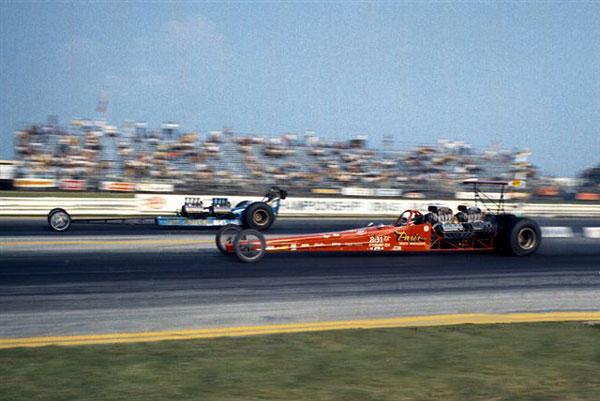
"Dinosaur, Indy, 1973: This was in the heyday of the dual-engined-car era. There were a ton of twin-engined Top Gas dragsters running, but there were not a lot of twin-engined Top Fuel cars, at least not in the Midwest. So when I saw Jim Bower’s front-motored injected twin pull up against Rico Paris’ rear-engined blown twin, I liked the contrast and knew I had to get a shot of both cars. Luckily, Indy had the break in the guardwall about 60 feet out, so I was able to get a pan shot of both cars. I have never seen another race between two-engined Top Fuel cars."
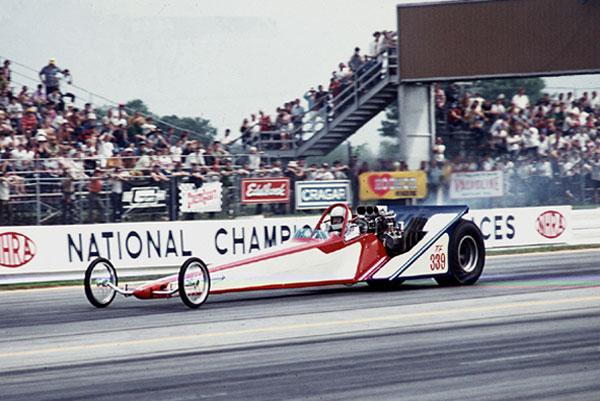
"Kalitta launch: Indy Nationals 1971. Connie Kalitta drove Pancho Rendon’s new wedge Top Fuel car on its maiden (and only) run. The car got up on its left side just before the finish line and flew into the Marathon finish-line sign, totally destroying the car. Kalitta walked away. The photo is especially meaningful to me because not five minutes before the crash, I was standing on the very spot where it crashed, talking to Ron Rickman, who was the NHRA finish-line monitor. When the fuelers fired, he told me I’d better leave, so while walking toward the starting line, I was able to get this shot. Life magazine ran a tremendous photo sequence of the crash showing Rickman running for his life as the car was crashing into the sign beside him."
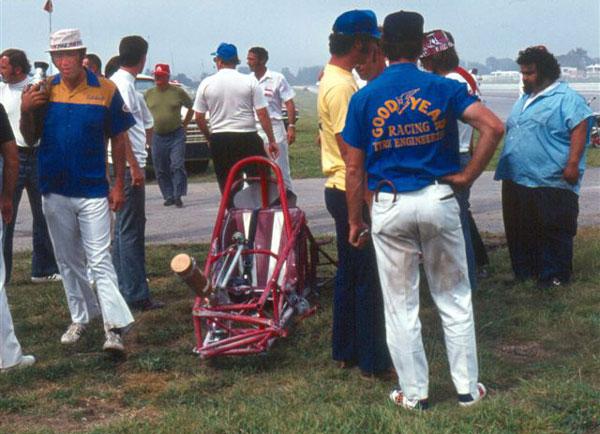
The Kalitta aftermath. That's ND's Leslie Lovett at left. "This photo is meaningful to me because this is when I first met Leslie Lovett. He was always willing to help a young photographer."
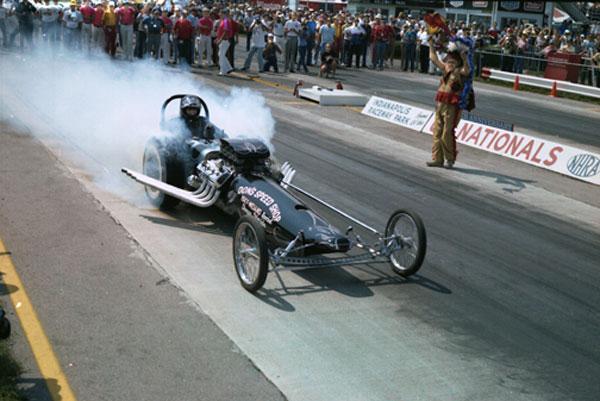
"Garlits’ Swamp Rat I at the 25th annual U.S. Nationals. Garlits brought the recently finished car to Indy, but I don’t think many people knew he was going to run it. Bob Daniels push-started the dragster with his '55 Chevy, and it sure brought back a lot of memories about how they used to do it. The area behind the starting line was packed with drivers, crewmen, officials, and anyone else who could sneak back there. You can see Kalitta, 'Snake,' Colson, Beck, and a bunch of others watching this historic run. Garlits lined up on the outside of the lane to avoid the rubber on the track and had a crewman wipe the tires with a wet rag to make sure the tires would smoke without abusing the clutch. I made sure I placed myself so I could get the whole scene. I thought it a unique touch to have Bob Beezer, the Canadian Indian who used to do a (non)rain dance on the starting line back in the early '60s as a flagman. This was a very moving moment for those who were there."

"I've been addicted to drag racing since my older brother let me tag along to the Akron [Ohio] airport about 1958," said Schiltz. "They used to run on one of the access roads. Arfons, Otie Smith, and a number of others got their start there. When I got my driver's license, I spent every weekend at the drags, primarily Dragway 42. Went to Indy Nationals with some high school pals in 1961 and returned every year until about 2000. 39 consecutive years!
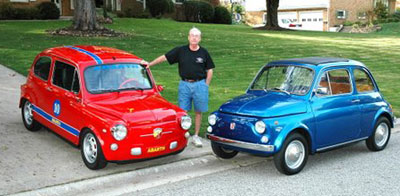 |
"I started shooting real photos about 1965 when I approached the sports editor of the local paper and inquired as to why there was never any coverage of local racers who were doing well. His reply was that nobody in the sports department knew anything about the sport. I made him a deal that if he'd get me credentials, I'd supply him with stories and photos. Having press credentials afforded me the opportunity to meet my heroes; Steve Reyes, Jim Kelly, Jon Asher, Jeff Tinsley, Tim Marshall, and Les Lovett. They all helped me grow as a photographer."
Schiltz also is well enough to remind me of his long ties to NHRA.com and how he was the one who supplied the digital images for the first NHRA special-event Web site, from the 1998 U.S. Nationals.
"I had a first-generation Kodak digital camera," he recalled. "It had about three-quarter-second shutter lag. You got me credentials, and I came to Indy. There was a group of guys in the base of the tower who would take my memory card and download to the Web. I remember you used about 50 of my images.
The "group of guys in the base of the tower" were the fine folks from goracing.com, who partnered with us in 1995 to build the first official NHRA Web site, and three years into the deal, before it was really popular to do so, we built this amazing (well, for back then; today it's a common deal) special site. This was way before digital cameras or even scanners were in every hand, but Tom had one and offered to be the eyes for us. That event, for you online history buffs, also featured the first audiocast from an NHRA event.
Again, as common as it is now, back then it was amazing technology. I remember well that there were some glitches. We had hyped it up so much, and when we didn't hit our planned airtime (we were late by about three minutes), I remember being so frustrated that I punched the tower door because none of us really understood how it worked, and for about 90 seconds, it looked as if it wasn't going to work. It did, and the rest is history.

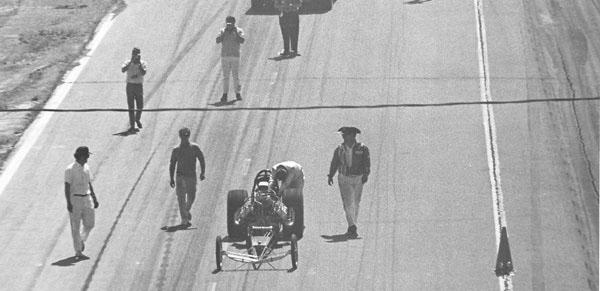
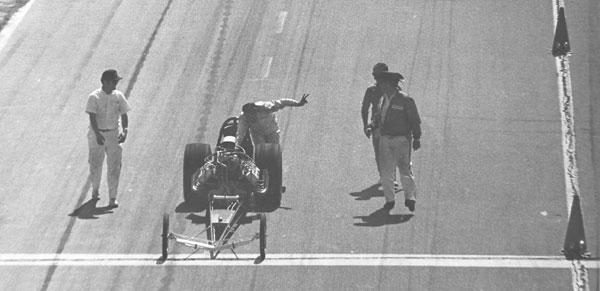
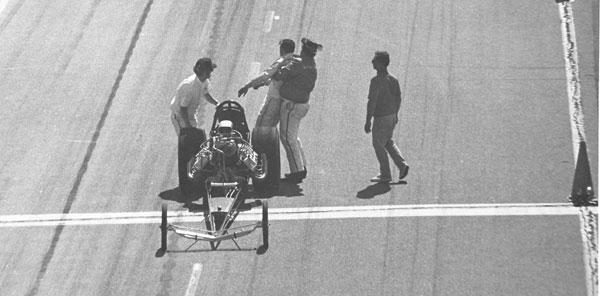
Last week, I showed you the picture of Walt Stevens collapsing on the Riverside track while trying to push his broken dragster down the track against equally broken opponent Bill Dunlap. Drag racing history wiz Stephen Justice whipped me these images, taken by the immortal Steve Reyes (that guy was everywhere!) from Riverside's crossover bridge that show Dunlap's valiant battle against weight, gravity, and heat.
In this three-shot sequence, you can see Dunlap pushing the car as a trail of curious onlookers and his team trail, then him flashing the "V for Victory" sign as he crossed the finish line before collapsing into John Halstead's arms. "It was so hot, I thought I was going to photograph a heart failure right on the racetrack," remembered Reyes.

Speakng of hot, that was the reaction to Tuesday's column on fire burnouts as everyone seemed to have a roaring good time with the pics and the comments from the irrepressible Tommy Ivo. Frequent Insider correspondents Howard Hull and Cliff Morgan, both former OCIR denizens, shared their memories of fire burnouts at "the County."
" 'Jungle' [Jim Liberman] used to do them all of the time at OCIR, and we would watch ['Berserko Bob' Doerrer] most likely, toss the match as he rolled through the puddle of gas," recalled Hull. "Several times, the starter would use the CO2 extinguisher to put the fire down, and afterwards, they figured the cost to refill them was a bit expensive, so back to squirting water on the fire to dilute it. Walking through it all night, it got on our shoes and pants. I remember getting into the car to leave, and my dad asked why I smelled of gas! We drove the old Country Squire Ford wagon home with the windows down!"
"Loved the story about the fire burnouts and especially the Ivo stories," said Morgan. "Next time you talk to him, tell him that he was the first 'name' driver I ever saw, at San Fernando around 1962 in the Ernie's Camera dragster. Anyhoo, speaking of San Fernando, I once saw a beer burnout there. Don't remember who the car or driver was, but the announcer made a big deal about how they were wasting beer on a burnout. Also remember in the '70s when Pro Comp was running that guys used to paint the slicks with traction compound. They'd put it on the tires in the pits with a rag or paintbrush. Of course, when they towed the car to the line, the sticky tires picked up rocks and debris. So when they'd do the burnout, all that stuff came flying off the tires, and you better not be standing behind the car!"
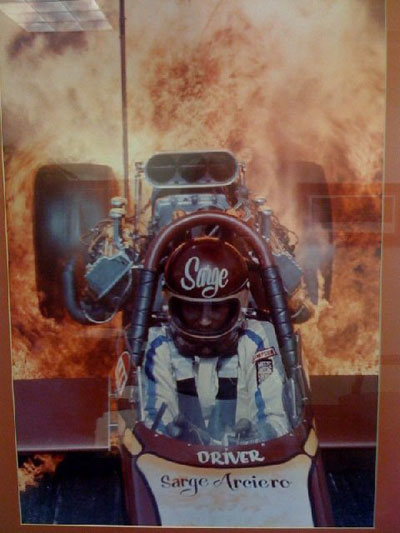 |
Mike Lewis, who holds the lofty title of senior vice president at Don Schumacher Racing when he's not racing nostalgia cars or running Top Alcohol Dragsters, passed along this shot from his days as a Top Fuel car owner in the 1970s.
"Here's a photo of a photo of a Cars magazine cover shot we did with Sarge Arciero in our Sparkling Burgundy car in 1972," he wrote. "The shot was orchestrated by Jim Cutler and earned him numerous awards in addition to the magazine cover. We experimented with a few gallons of gas during a Maple Grove [Pa.] event but decided a more serious attempt was better suited to a quiet Tuesday morning.
"We fabricated a tripod that fastened to the frame, and Cutler mounted a motor-drive camera with remote control. He pre-focused on Sarge. We still push-started the car in those days, and I planned some hand signals with Sarge so he knew I lit the fire and when to do his burnout. The best-laid plans sometimes go awry.
"We started the car and helped Sarge straighten it in the right lane at Maple Grove. My brother then dumped a full five-gallon jug of gasoline onto the rubber-coated burnout area. The plan was to push Sarge back into the gasoline and light the match, but the header flames ignited the fuel-soaked tires. Sarge was unaware and waited for me to light the match. I gave him the signal to do the burnout, but he shook his head. He soon felt the heat, and I signaled one more time. All the while, Cutler's camera clicked off a dozen frames.
"The burnout itself was spectacular and yielded many great frames before the tires began to smoke. We were shocked to see the car come to a stop with every piece of chrome blackened and two spark-plug wires burned off. Worst of all, Cutler's precious camera (owned by the Reading Eagle) had come loose and was dangling from its mount. We left the track thinking our efforts were for naught. Not so, luckily. The mount broke as the result of Sarge's sudden stop. He was hot and wanted out of the cockpit.
"I still have the magazine and a faded 16x20 at home but I ran into Jim several years ago before he passed away. By coincidence he had just digitized the shot and promised to make a print for me. I had just moved into my new office at the new DSR shop in 2005 when a package arrived containing a beautifully framed print of our 1972 fire burnout. I'll never forget Sarge, the burnout ... or Jim Cutler!"

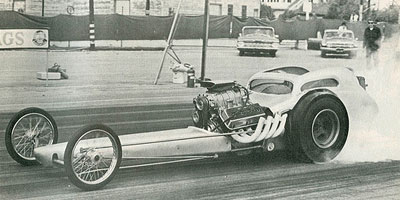 |
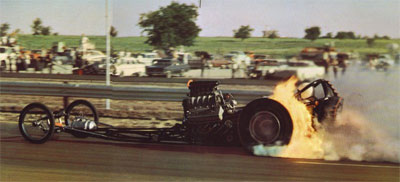 |
Another topic that came up several times in the course of e-mails discussing fire burnouts was the seemingly accidental torching of the slicks during a run.
Jim Hill, a lifelong drag fan and former member of Crane Cams' Racing Department, recalled how "Flaming Frank" Pedregon, the Ramchargers, Nick Marshall and the Marshall & Vermilya dragster, Bennie Osborn, and several others did this at the Nationals in 1966 or 1967. "Many believed it was purely a 'circus act,' but others insisted it was a drag racing phenomenon produced by extreme horsepower and tire spin in those lockup clutch, smoky-run days," he wrote. "So, what's the real scoop here? Fiction or fact?"
Jim's question reminded me of a thread in the Standard1320 newsgroup on this topic, and I remember several of the uber veteranos there positing that there were several possible explanations for this phenomenon. I also was sent this pic of Texas drag racing hero Bobby Langley lighting the slicks afire on a run (this is back in the days before burnouts) and remember longtime drag journalist Forrest Bond recalling that Langley's car had an inordinate amount of rubber accumulated to its flanks behind the rear tires and that perhaps that had combusted. Another suggested that the fine powder of rubber burning off the tires could easily catch fire in that combustible environment (high heat from the headers, air, fuel mist) much in the way that grain silos sometimes spontaneously combust and that perhaps the fendered tires of "Flaming Frank's" coupe provided the a good "catch" environment to produce the fire on the tires.



















































